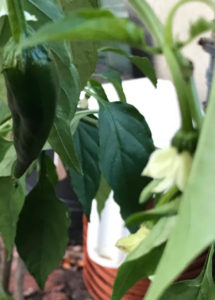 So. The snows did come. And the winds really blew. We were between municipalities with declared states of emergency from the 23rd to the 26th. That’s the view out the front of nearby Matron Fine Beer, announcing on FB that they were shut on Boxing Day. The 900 km two day round trip was not taken. We stayed in.
So. The snows did come. And the winds really blew. We were between municipalities with declared states of emergency from the 23rd to the 26th. That’s the view out the front of nearby Matron Fine Beer, announcing on FB that they were shut on Boxing Day. The 900 km two day round trip was not taken. We stayed in.
According to me? Isn’t that what all this all is all about? Over the now near twenty years of doing this, I have only had one question: why? It’s a hobby, I suppose. And maybe a bit of a diary. But, looking back, it’s also an archive. A searchable database that’s become a bit of an encyclopedia. Maybe. As I may have mentioned, I dove back into reading quite seriously this year. I’m on my fiftieth book . Unfortunately, ruining my pace, I’ve been reading it for a month that fiftieth book. Cultural Amnesia by Clive James. It’s an excellent 850 page set of 120 bios of the greatest or most compelling writers or most murderous political figures selected – and to a certain degree cross referenced – by James to explain where we all were as of 2008 when the book was published.
Bear with my side track. Please. It’s turned into a bit of a one household dinner party week and I’ve been dipping in and out of here and the book. See, the book is effectively an encyclopedia of criticism, written by a great critic effectively criticizing modernity. It’s oddly organized. Alphabetical. Not in terms of the chronological order of those in the bios. Good to obey the chronology. And not ordered in terms of the progress of thought or even the order that James encountered those thoughts. Each bio from A to Z has a sketch of the life, an aphorism by the subject and then a critical examination of the thought. I am struck over and over by my own stupidity in light of all these thoughts. Never heard of more than half of the people included in the 120, let alone their century defining aphorisms. But it has given me a bit of heart, you know, related to the importance of careful critical reading – even when the care is taken with reading about the tiny odd corner of society filled by the beer trade… something that isn’t really quite at the same level as James’ concern, you know, when compared with the question of humanity’s serial genocidal tendencies.
So… is this place all an unintentional oddly organized niche encyclopedia? Perhaps a compendium. Or a gazetteer. Could be. A diary of thoughts. Can’t really say. Not done yet.
The Last Weekly News Notes
As you think about all that, there were a few note worthy things happening in the world of beer over the quiet holiday week. First, Ron held his annual Christmas Day Drinkalongathon which, given the six hour time difference, was not going to happen in my house:
I’m starting with the traditional bacon sarnie and fino sherry. I usually go on about the saltiness of the whatsit complementing the brinyness of the whatsit. But today I’m just enjoying stuffing some greasy meat into my gob, whilst slowly easing my body into the boozy assault that is to follow. Yum…
Other odd forms of praising Christ’s birth were noted. Getting dressed up and drunk on Boxing Day is a thing in Wigan according to the UK’s Daily News which published a photo essay with scenes like this:
People stumbled home and had a rest against buildings and on pavements after a big night out at the Boxing Day annual fancy dress night in Wigan. A couple of traffic cones made sure a woman was okay as she sat on a pavement, a man wearing a dress – Freddie Mercury style – was shouted at and pushed away outside the Popworld nightclub by another woman. Several grabbed a takeaway to soak up the booze as they awaited taxis.
And the far more sedate Tand himself has written up a recent visit to Northern Ireland and spotted an interesting fact about his first pint:
Our choice? Well, Guinness of course – you have to for your first at least don’t you, and this was a fine example of what I regard as a pretty unimpressive beer. I had learned before I went there that the gas mix in Ireland – presumably including the North too – is a 75/25 nitrogen to CO2, whereas in GB it is 70/30, making for a less creamy and smooth pint than in Ireland.
More western hemispherically, Josh Noel noted the continued odd economics of Goose Island Bourbon Stout and its shift to the discount shelf in the same year of issue, tweeting:
The more I think about it, the simpler it all seems — it’s just way overpriced. All of it.
Yup.****
Conversely, we still have these sorts of PR plugs that everything is A-OK despite the brewer closures:
“It used to be that the kind of the craft, or the weird, let’s call it, beers were just for fringe, like people who maybe that identified themselves as being different,” said Christine Comeau, executive director of the Canadian Craft Brewers Association. “But now we’re seeing that craft beer, it’s appeal has gone beyond just kind of the fringe drinkers way more into the mainstream. I think that the brewers themselves are making beer that’s really approachable, I think consumers are recognizing they enjoy the variety of tastes and flavours and the experience of it.” Comeau said over 1,100 craft breweries operate in Canada, and that number is continually growing.
Not sure how much – if any – of that is fully true. But we could say that about so much, couldn’t we. About so much.
Best of 2022
Let’s get to this. Right away. Errr.. first, some context. As I sat down at the very outset, to begin compiling this my list of the best in beer writing for 2022, the Argentine and then the French national anthems played on my TV. Full of anxiety and a bit excited, I wondering if I should have a drink at 10 AM on a Sunday to steady the nerves. Why? Not because of the World Cup Final that’s playing in the background. No, it’s because Boak and Bailey have just published their own insanely detailed 2022 best in beer writing blog post. Holy frig. The effort. I quickly realized that there was no point of replicating the work they have put in. Any efforts I make will be half assed in comparison. I knew this so immediately mainly for one reason – because I am always half assed in comparison.
Still… I will not be totally deterred by excellence in others. It’s not my way. As you know. Mirroring B+B, I will say that I too drew from a wide range of sources this year, the quality of which differs. I am a reasonably generous patron of Pellicle which, for me, really stands alone in terms of quality and focus.*** It’s the NPR of beer writing. Other sources still are out there competing and providing genuine surprises, sources like the few remaining newspaper columns and articles, the business tied publications like Ferment and the Good Beer Hunting (now more and more a travelogue borg) along with the fading phenomenon of podcasts, the obstinately stalwart blogs, not to mention the more resilient of those newer things the hybrid “blog meets pen-pals” that some folk still call newsletters.* Each are in their own way goal oriented, whether commercial or just aspirational. Folk jockeying and seeking their wee thin slice. As they should. Each also has their own editorial slant that affects what’s covered – or, more importantly, what they won’t dare or just couldn’t be bothered to touch (given those goals I mentioned – not to mention the guiding hand of travel association funding.) But, knowing all that, it all still forms a pretty vibrant if messy scene that seldom fails to offer a good selection of reading week after week. We should all be grateful for that.
Fine. Let’s get to it. What’s the winner? Let me perhaps first further preface my extended preamble with this one caveat: I also can’t see myself studying stats per author as B² did even if a number of top year-long writing efforts clearly stand out. It’s me, not you. Or them. Is it them? Yes, it’s them. One problem I face when putting them all together is that I don’t necessarily limit my references to articles. I equally mention conversational points made by folk like Lars, Martyn and Ruvani received by DMs, emails and in social media as much as I cite longer posts like those of Ron and of Gary – who has gone to a new level in 2022. The epigram is as valid as the essay but you sure can lose track. It gets a bit messy. And, looking back, how would I even search the stuff given, as I have to admit by way of example, I seem to have about sixteen nicknames for Matthew… Matty C… The Mattimeister 3000.** Plus, you get side tracked about people. Frankly I find myself fretting over the state of JD-TBN‘s liver and Delores’s patience with every notification of another post. That all being said, counting my fingers and toes, I can confirm that both NHS Martin and Beth Demmon had 12 full standalone pieces mentioned here in this place over 2022. By comparison, Eoghan had only six mentions – but all from his fabulous, his epic perhaps even heroic series A History of Brussels Beer in 50 Objects which started in mid-2021 and carried over through the first half of 2022. Each of those mentioned above (and, sure, others) in their own way are tied for most attention grabbing beer writer of the year… well, hons ments.
So the best thing in beer writing this year… quite specifically? I think I was pretty clear back in November when I wrote about David Jesudason’s “Please Don’t Take Me Home — How Black Country Desi Pub Culture Made Football More Diverse” in Pellicle, stammering and stumbling my thoughts:
… calmness in the moment. There are none of the burdens² ³ ⁴ … in this piece like all the best sort of writing there is also a person and a moment. The scene being seen. I’d be at this pub regularly… if it was in my town… and if Canada has the same sort of pub life… which it doesn’t.
You can click through for those footnotes. No need to repeat the dreary comparisons. Everything fails a bit in comparison. Just have a look at his essay itself. Simple and generous. Proud and objective. Lovely. One thing I suspect is going on here is that David Jesudason came to beer as an already established good writer, having credits including at the BBC and The Guardian. Beer, being a fairly low value topic in terms of both substance and reward, doesn’t usually attract the more established version of the good writer – even if it’s been a strong training ground. I expect the addition of social justice issues and authors to the curriculum over the last few years has probably made helpful space for interesting views – especially when that spot is not appropriated by the non-marginalized.***** Even with this shade, welcoming more skilled writers and their writing is great, the best shaking up what is otherwise a pretty fixed format.
Finally, best new thing in beer writing generally? Wait for it. Mastodon. Yup. I was thinking about it earlier this week when Maureen Ogle was lamenting the death of her #BeerTwitter community. I replied…
…the values are different. Were you writing when the RSBS feed was discontinued? Maybe 350 beer sites updated daily and you got a notice by email. Its death caused a reordering. New readers. If Twitter is now dying, is another new reordering is happening? Here, you get followers with content. But many beer writers actually stopped writing some time ago too. And new voices have already moved in on the turf. Is a big shift on?
My conclusion… wait for it! Have faith. Just as the death of craft doesn’t mean the death of beer, so too the death of Twitter is not the death of thought… err… and anyway – didn’t that happen with the creation of Twitter? You have to be patient. Mastodon works differently. More carom billiards than 8 ball, more rugby than darts. Hashtags are more important than retweets… aka boosts. Big hint? Follow #BeerWriting and include #BeerWriting in every post. Folks gather. Don’t believe me? Follow #Birding. Happy to help. Questions in the comments will be answered. Fine, maybe this is really a 2023 forecast. Only you can decide if that is or isn’t the case.
One more best? Godspeed Brewing out of Toronto. I bought many a case for home delivery this year. Their Tmavý Ležák 12º is fabulous. For me, now figuring out what being somewhat gluten intolerant means, that’s a bit more praise than I had expected to be able to give.
Finally, the Festival of Beer Links
Think of these as the movie credits. Continuing a now week-long tradition, Boak and Bailey added a new feature to their weekly post recently which I am slowly building upon, too – a shared list of beer writing resources on Mastodon:
Boak & Bailey | The B² experience
David Jesudason | “Desi Pubs” (2023) author
Ron Pattinson | The RonAlongAThon Himself
Al Reece AKA Velky Al | Fuggled
Jennifer Jordan | US hops historian
Alan McLeod | A Good Beer Blog (… me…)
Andreas Krennmair | Vienna beer and lager historian
Beer Ladies Podcast | Lisa Grimm and colleagues
Jay Brooks | Brookston Beer Bulletin
Joe Stange | Belgian beer expert, beer magazine editor
Cider Bar | Barry makes Kertelreiter cider
Laura Hadland | CAMRA historian and beer writer
Brian Alberts | US beer historian
Jon Abernathy | The Beer Site
Maureen Ogle | US Beer Historian
Lars Garshol | Norwegian Beer Historian and Kveik Hunter
Carla Jean | MAINER!!!
Thandi Guilherme | Beer Ladies Podcast Co-host
Lisa Grimm | Beer Ladies Podcast Co-host
Rob Talksbeer | Podcaster and Youtuber
Anthony Gladman | UK Drinks Writer
Jeff Alworth | Manna Of Beervana
Evan Rail | Prague based GBH editor, freelance writer, NYT etc.
Try those folk as, again, we might not have a weekly weekend update this week from Boak and Bailey as we usually see mostly every Saturday and perhaps also not one from Stan at his spot on Mondays. It’s still the holidays. So, look around and check to see if there is the highly recommended Beer Ladies Podcast. The OCBG Podcast is on a very quiet schedule these days – but it was there last week! See also sometimes, on a Friday, posts at The Fizz as well (Ed.: we are told ‘tis gone to 404 bloggy podcast heaven… gone to the 404 bloggy podcast farm to play with other puppies.) And the long standing Beervana podcast (Ed.: which I have missed from this list for some unknown reason.) There is the Boys Are From Märzen podcast too and check out the travel vids at Ontario’s own A Quick Beer. There is a monthly sort of round up at The Glass. (Ed.: that seems to be dead now… nope, there was a post on July 25th… in 2022 even.) There is more from DaftAboutCraft‘s podcast, too. And sign up for Katie’s (Ed.: now very) irregular newsletter, The Gulp, too. And check out the Atlantic Canada Beer Blog‘s weekly roundup. Still gearing up, the recently revived All About Beer has introduced a podcast, too. (Ed.: give it a few weeks to settle in and not be as agreeable… not sure this went very far…) Plus follow the venerable Full Pint podcast. And the Craft Beer Channel this week on Youtube. Plus Fermentation Radio with Emma Inch. The AfroBeerChick podcast as well! And also look at Brewsround and Cabin Fever. And Ben has his own podcast, Beer and Badword (Ed.: …notice of revival of which has been given… still not on the radio dial…) And remember BeerEdge, too, and The Moon Under Water. There was also the Beer O’clock Show but that’s now gone after a ten year run… no, it is back and here is the link!
*I wrote that and just before the first half of the final game (Argentina up 2-0 at 44:19) realized what I hadn’t included – books! Remember beer books? I wonder if I will mention one I really like this year… let’s see… (later… nope…)
**OK, that’s actually a new one.
***…even if it still published a few wowsers like the stunningly revisionist reference to the genocide in NNY against the Haudenosaunee.
****Remember when people thought “sucker juice” was a dumb mean thing to say? That was great.
***** … and where a bit oddly forced given the history, just fleeting or (worst) leveraged by the crass coat-tailing personal promoters with sticky fingers…




















